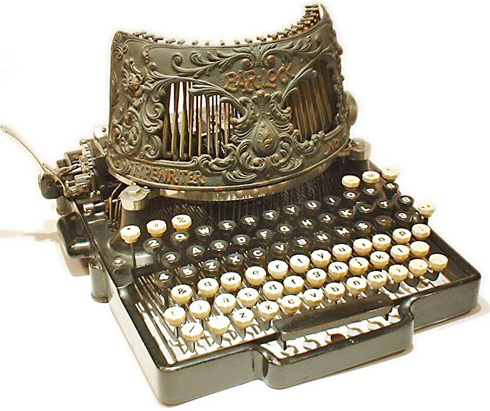


Framed or unframed, desk size to sofa size, printed by us in Arizona and Alabama since 2007. Explore now.
Shorpy is funded by you. Patreon contributors get an ad-free experience.
Learn more.

- Freeze Frame
- Texas Flyer wanted
- Just a Year Too Soon
- WWII -- Replacing men with women at the railroad crossing.
- Yes, Icing
- You kids drive me nuts!
- NOT An Easy Job
- I wonder
- Just add window boxes
- Icing Platform?
- Indiana Harbor Belt abides
- Freezing haze
- Corrections (for those who care)
- C&NW at Nelson
- Fallen Flags
- A dangerous job made worse
- Water Stop
- Passenger trains have right of way over freights?
- Coal
- Never ceases to amaze me.
- Still chuggin' (in model form)
- Great shot
- Westerly Breeze
- For the men, a trapeze
- Tickled
- Sense of loneliness ...
- 2 cents
- Charm City
- What an Outrage
- Brighton Park
Print Emporium
Shipshape: 1897

March 16, 1897. "U.S.S. Brooklyn, office of executive officer." Note the ancient typewriter. 8x10 inch glass negative, Detroit Photographic Co. View full size.
Two things that seem wrong
A yeoman was a left arm rating, not right arm. And it looks as if he has a lanyard around his neck and the only thing it should be connected to would be a bosn pipe,and because he is not in the deck division would not be eligible to use it.
Batten the Hatches
From what I have read, it was SOP during battle stations to button up the portholes with these removable covers, and severe penalties were meted out for non-compliance. They were a known weakness, but a necessity in the days before air conditioning.
Also, all the cabinetry, including the roll-top cover, are equipped with locks. And it appears that heavy typewriter is bolted down. So I don't think any loose projectiles would be left in place with the exception of those pesky chairs!
Probably not Ellis
landtuna - If Wikipedia is to be believed, we wasn't serving at the time of this photo - he was honorably discharged in October 1896, and didn't re-enlist again until May of 1897, two months after this photo was taken.
That said, there's a strong chance that this could be the guy Ellis replaced, which possibly could be used to track down and ID who it is.
E-6
Our gallant young sailor looks like a Petty Officer 1st (PO1) which corresponds to the rank of Staff Sergeant in the Army and Marines all E-6s.
HEADS UP!
I wouldn't want to be in there underway or especially in battle.
My battle station was as photographer glued to the side of the Captain, documenting whatever happened. I had the misfortune of being in the Wardroom during a firing exercise. The ship I was on (USS Fulton AS-11) was doing a firing exercise with the 5"/30 guns. When the first round was fired, anything not bolted down went flying through the air! All paneling flew off the walls. Books and paper were flying like birds.
Under heavy seas, if it can't be fastened down, it needs to be put low or away. Notice the porthole cover above the porthole, although resting in place, it is not secured. If that office is near any operating guns, it will be flying off the bulkhead and be a deadly projectile. That Yeoman would have quite a mess and possibly a be wearing a porthole cover in his head!
Faceguard
Interesting faceguard on the typewriter. Was that in case the keys flew off and headed for you?
[The semicircular "face guard" part of a typewriter is called the segment; its job is to hold the type bars. The machine in our photo is a Bar-Lock front-strike model, which was an improvement on understrike typewriters. In a modern typewriter, the segment and type bars are rotated 90 degrees so you can see what you're doing. - Dave]
Asbestos!
In reply to Person From Porlock, I would surmise that the pebbled coating has been applied primarily as a fireproofing material in addition to lesser benefits including insulation and sound deadening. The wonderful properties of asbestos were well known during the industrial age and it was used with careless abandon.
Of course the idea wasn't to prevent the steel or iron from catching fire but to slow down the effects of the heat that would buckle and collapse the metal structure.
I'd like to see how they got that roll-top desk into those cramped quarters. I have been in a few WWII era ships and there sure wasn't much wiggle room in the companionways and ladders!
Looks like the same typewriter
Bar–Lock 4 from the Columbia Typewriter Co. of New York. More here.

Paint?
Anyone know why the highly textured paint?
























On Shorpy:
Today’s Top 5